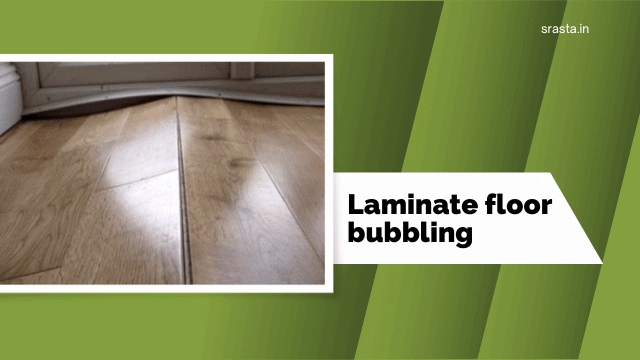Laminate flooring is a popular choice for homeowners due to its durability, affordability, and ease of maintenance. However, even the most well-maintained laminate floors can experience issues, one of which is bubbling. If you’re facing this issue, this article will help you understand the causes of laminate floor bubbling, ways to prevent it, and steps for repairing it.
1. Introduction
Laminate floor bubbling is a common issue that homeowners face. This occurs when the planks or tiles of laminate flooring separate from the subfloor and begin to rise, creating a bumpy or uneven surface. Bubbling not only makes the floor unsightly but also poses a tripping hazard. Fortunately, it is not a difficult issue to resolve if you take the right steps.
2. What is Laminate Floor Bubbling?
Laminate floor bubbling is the process of the laminate flooring planks or tiles rising above the subfloor. This can occur in specific areas or across the entire floor. Bubbling is caused by a separation of the flooring from the subfloor, typically due to exposure to moisture or poor installation.
3. Causes of Laminate Floor Bubbling
Understanding the causes of laminate floor bubbling is crucial to prevent it from occurring.
3.1 Water Damage
Water damage is a common cause of laminate floor bubbling. When laminate flooring is exposed to water, the planks or tiles can absorb the moisture, causing them to expand and separate from the subfloor. This issue can be caused by water leaks, spills, or even excessive humidity levels.
3.2 High Humidity Levels
High humidity levels in the home can cause laminate flooring to bubble. This is because moisture in the air can seep into the flooring and cause the planks or tiles to expand. If the humidity levels in your home are consistently high, it can cause long-term damage to your flooring.
3.3 Poor Installation
Laminate floor bubbling can also occur due to poor installation. When the planks or tiles are not installed correctly, they can easily separate from the subfloor, leading to bubbling. It is important to hire a professional installer with experience in laying laminate flooring.
3.4 Uneven Subfloor
An uneven subfloor can also cause laminate floor bubbling. When the subfloor is not level, it can cause the planks or tiles to separate from the subfloor, leading to bubbling. It is essential to ensure that the subfloor is level before installing laminate flooring.
4. Prevention of Laminate Floor Bubbling
Preventing laminate floor bubbling is easier than repairing it. Here are some tips to help prevent it from occurring.
4.1 Proper Installation
The first step to prevent laminate floor bubbling is to ensure proper installation. Hire a professional installer who has experience in laying laminate flooring. A well-leveled subfloor and correct installation can prevent the planks from separating from the subfloor and causing bubbling.
4.2 Control Humidity Levels
Controlling humidity levels in your home is also important to prevent laminate floor bubbling. Use a dehumidifier or air conditioner to keep the humidity levels in your home between 30% and 50%. This will prevent moisture from seeping into the flooring and causing it to expand.
4.3 Address Water Damage Quickly
If you have any water leaks or spills on your laminate flooring, address them quickly. Use a towel to dry up any spills immediately and use a fan or dehumidifier to dry out any water damage. Addressing water damage quickly can prevent the planks from separating from the subfloor and causing bubbling.
5. Repair of Laminate Floor Bubbling
If you have already experienced laminate floor bubbling, you can repair it by following these steps.
5.1 Identify the Problem
Identify the area where the bubbling is occurring and inspect the flooring for any signs of water damage or poor installation. If the damage is due to water exposure, ensure that the water source is addressed before proceeding with repairs.
5.2 Remove Damaged Boards
Remove the damaged boards by using a saw or chisel to cut along the edges of the board. Once the board is removed, inspect the subfloor for any damage or unevenness.
5.3 Replace with New Boards
Cut new boards to the same size and shape as the damaged boards and fit them into place. Make sure that the new boards are level and flush with the existing flooring.
5.4 Reinstall and Finish the Floor
Reinstall the baseboards and trim around the repaired area and apply the same finish as the rest of the floor. Allow the finish to dry completely before using the floor again.
6. Conclusion
Laminate floor bubbling is a common issue that homeowners face, but it can be prevented and repaired with the right steps. Understanding the causes of bubbling, preventing it from occurring, and repairing it properly can ensure that your laminate flooring lasts for years to come.
7. FAQs
Can laminate floor bubbling be repaired?
Yes, laminate floor bubbling can be repaired by removing the damaged boards and replacing them with new ones.
How can I prevent laminate floor bubbling?
You can prevent laminate floor bubbling by ensuring proper installation, controlling humidity levels, and addressing water damage quickly.
Can laminate flooring be installed in a bathroom?
Yes, laminate flooring can be installed in a bathroom, but it is important to ensure that the subfloor is level and that the flooring is properly sealed to prevent water damage.
How long does laminate flooring last?
Laminate flooring can last for up to 25 years with proper installation and maintenance.
Is it necessary to hire a professional installer for laminate flooring?
While it is possible to install laminate flooring on your own, hiring a professional installer can ensure proper installation and prevent issues like bubbling.
